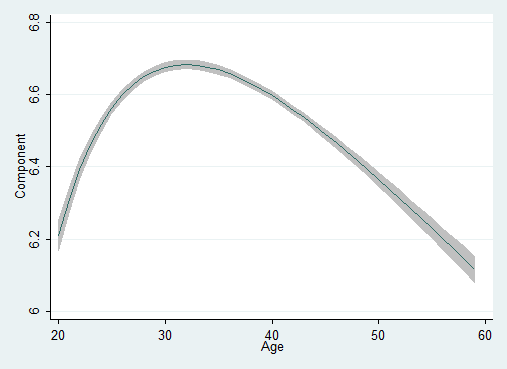
Fractional polynomials | Order |

Fractional polynomials are an alternative to regular polynomials that provide flexible parameterization for continuous variables.
For example, say we have an outcome y, a regressor x, and our research interest is in the effect of x on y. We know that y is also affected by age. One solution to this problem would be to fit a linear regression of the form
yi = b0 + b1*xi + b2*agei + b3*agei2 + ui
An alternative would be to control for age using fractional polynomials:
yi = b0 + b1*xi + b2*agei(p1) + b3*agei(p2) + ui
The parentheses are significant. Fractional powers are different from regular powers. For instance, age(0) is ln(age). You can see the full definition, but one example will demonstrate the power of fractional polynomials.
To fit the fractional polynomial model, we type
. fp <age>: regress y x <age> (fitting 44 models) (....10%....20%....30%....40%....50%....60%....70%....80%....90%....100%) Fractional polynomial comparisons:
| age | df Deviance Res. s.d. Dev. dif. P(*) Powers | |
| omitted | 0 -83.145 0.237 625.517 0.000 | |
| linear | 1 -179.287 0.232 529.376 0.000 1 | |
| m = 1 | 2 -295.392 0.225 413.270 0.000 3 | |
| m = 2 | 4 -708.663 0.203 0.000 -- -.5 -.5 | |
| Source | SS df MS | Number of obs = 2000 | |
| F( 3, 1996) = 347.37 | |||
| Model | 42.8971855 3 14.2990618 | Prob > F = 0.0000 | |
| Residual | 82.1620986 1996 .041163376 | R-squared = 0.3430 | |
| Adj R-squared = 0.3420 | |||
| Total | 125.059284 1999 .062560923 | Root MSE = .20289 |
| y | Coef. Std. Err. t P>|t| [95% Conf. Interval] | |
| x | .7954347 .0466225 17.06 0.000 .7040008 .8868686 | |
| age_1 | 11.04709 .4085977 27.04 0.000 10.24577 11.84841 | |
| age_2 | 13.17616 .4991682 26.40 0.000 12.19722 14.15511 | |
| _cons | -8.059393 .5469551 -14.74 0.000 -9.132056 -6.98673 | |
We find that b1, the effect of x on y, is 0.80, but before we take that result seriously, we must ask ourselves whether we have adequately controlled for age.
. fp plot, residuals(none)

Notice the shape of the y versus age curve. We could not have obtained that shape using a standard quadratic. Fractional polynomials provide a wide range of shapes that include all the shapes provided by ordinary polynomials and more. The fractional polynomial parameterization did not predetermine that the shape we obtained was skewed right. Fractional polynomials can just as easily produce skewed left shapes.
We still need to do more to convince ourselves that the curve above is adequate, but we will not do so here.
See the fractional polynomial manual entry.
See New in Stata 19 to learn about what was added in Stata 19.